2012 Peugeot 508 RXH fog light
[x] Cancel search: fog lightPage 18 of 304

16
Familiarisation
Seeing clearly
Lighting
Ring A
Ring B
Wipers
143
Control stalk A: windscreen
wipers
2. Fast wipe.1. Normal wipe. Int. Intermittent wipe.
0. Park.
AUTO Automatic wiping.
�È Single wipe: Brief pull on the stalk towards.
Screenwash: Long pull on stalk towards you.
152
Switching on "AUTO" mode
�)Briefly push the stalk downwards.�)Briefly push the stalk downwards or place
the stalk in another position: Int, 1 or 2.
Ring B: rear wiper
154
15 3 Li
ghting off.
Automatic illumination o
f headlamps.
Sidelamps.
Dipped / main beam headlamps.
Rear
foglamps.
Park.
Intermittent wipe.
Screenwash.
Page 39 of 304

.
37
Hybrid system
Eco-driving
Eco-driving is a range of everyday practices that allow the motorist to optimise their fuel consumption and CO2 emissions.
Optimise the use of your
gearbox
Use automated mode Aas much as possible as this optimises gear changes to suit the
circumstances.
Drive smoothly
Maintain a safe distance between vehicles, use engine braking rather than the brake pedal, and press the accelerator progressively. These practices contribute towards a reduction in fuel consumption and CO2 emissions and also helps reduce thebackground traffic noise.
If your vehicle has cruise control, make use of the system at speeds above 25 mph (40 km/h) when the traffic is flowing well.
Control the use of your
electrical equipment
Before moving off, if the passenger compartment is too warm, ventilate it byopening the windows and air vents before using the air conditioning.
Above 30 mph (50 km/h), close the windowsand leave the air vents open. Remember to make use of equipment that canhelp keep the temperature in the passenger compartment down (sun roof and window blinds...).Switch off the air conditioning, unless it has automatic digital regulation, as soon as the desired temperature is attained.Switch off the demisting and defrosting controls, if not automatic.
Switch off the heated seat as soon as possible.
Switch off the headlamps and front foglampswhen the level of light does not require their use.
Avoid running the Diesel engine when stationary, par ticularly in winter; your vehiclewill warm up much faster while driving.
As a passenger, if you avoid connecting your multimedia devices (film, music, video game...), you will contribute towards limitingthe consumption of electrical energy, and soof fuel.
Disconnect your por table devices beforeleaving the vehicle.
Page 49 of 304

1
47
Instruments and controls
Operation indicator lamps
If one of the following indicator lamps comes on in the instrument panel and/or instrument panel screen, this confirms that the corresponding system has come into operation.
Warning / indicator lampStateCauseAction / Observations
Left-hand direction indicato
r
flashing with buzzer. The lighting stalk is pushed down.
Right-handdirection indicator flashing with buzzer. The lighting stalk is pushed up.
Sidelamps
fixed. The lighting stalk is in the
"Sidelamps" position.
Dipped beamheadlamps
fixed. The lighting stalk is in the "Dipped
beam headlamps" position.
Main beam headlamps fixed. The lighting stalk is pulled towards
you. Pull the stalk to return to dipped beam headlamps.
Ready fixed. The vehicle is ready to move off; you can press the accelerator. It comes on once high voltage is established in the
vehicle.
Rear foglamps
fixed. The rear foglamps are switched on. Turn the ring on the stalk rear wards to switch off the
rear foglamps.
For more information on the lighting controls, refer to the "Visibility" section.
Adaptive lighting
fixed. The lighting stalk has been pulled
towar
ds you and the button has been pressedIts warning lamp is on. The camera
, located in the interior rear view mirror,
authorises or not switching between main and dippedbeam, depending on the exterior lighting and thedriving conditions.
Pulling the lighting stalk to return to dipped beam.
Page 144 of 304
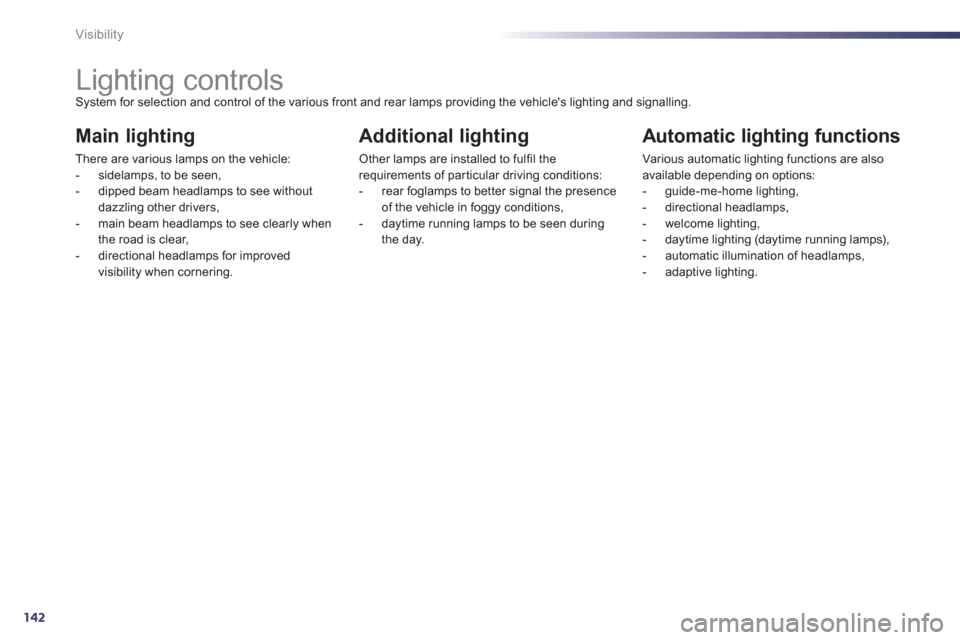
142
Visibility
Lighting controls System for selection and control of the various front and rear lamps providing the vehicle's lighting and signalling.
Main lighting
There are various lamps on the vehicle:
- sidelamps, to be seen,
- dipped beam headlamps to see without
dazzlin
g other drivers,
- main beam headlamps to see clearly when
the road is clear,
- directional headlamps for improved
visibility when cornering.
Additional lighting
Other lamps are installed to fulfil the requirements of particular driving conditions:
- rear foglamps to better signal the presence of the vehicle in foggy conditions,
- daytime running lamps to be seen duringthe day.
Automatic lighting functions
Various automatic lighting functions are also
available depending on options:
- guide-me-home lighting,
- directional headlamps,
- welcome li
ghting,
- daytime lighting (daytime running lamps),
- automatic illumination of headlamps,
- adaptive lighting.
Page 146 of 304
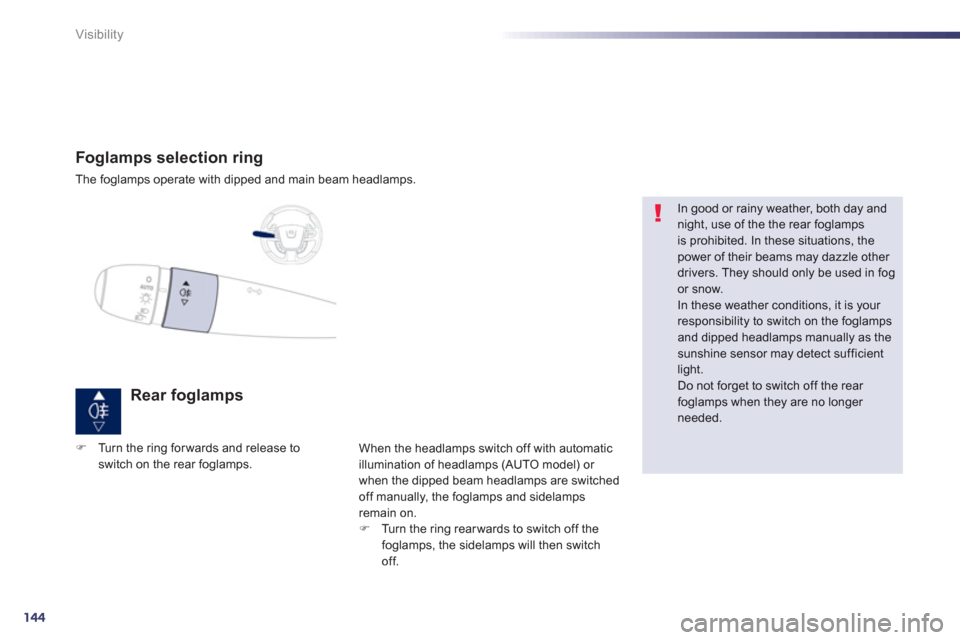
144
Visibility
Foglamps selection ring
The foglamps operate with dipped and main beam headlamps.
Rear foglamps
When the headlamps switch off with automatic
illumination of headlamps (AUTO model) or
when the dipped beam headlamps are switched
o
ff manually, the foglamps and sidelampsremain on.�) Turn the ring rear wards to switch off the foglamps, the sidelamps will then switchoff.
In good or rainy weather, both day andnight, use of the the rear foglamps is prohibited. In these situations, thepower of their beams may dazzle other drivers. They should only be used in fog or snow.
In these weather conditions, it is your responsibility to switch on the foglamps and dipped headlamps manually as the sunshine sensor may detect sufficientlight.
Do not forget to switch off the rear foglamps when they are no longer needed.
�)Turn the ring for wards and release to
switch on the rear foglamps.
Page 149 of 304
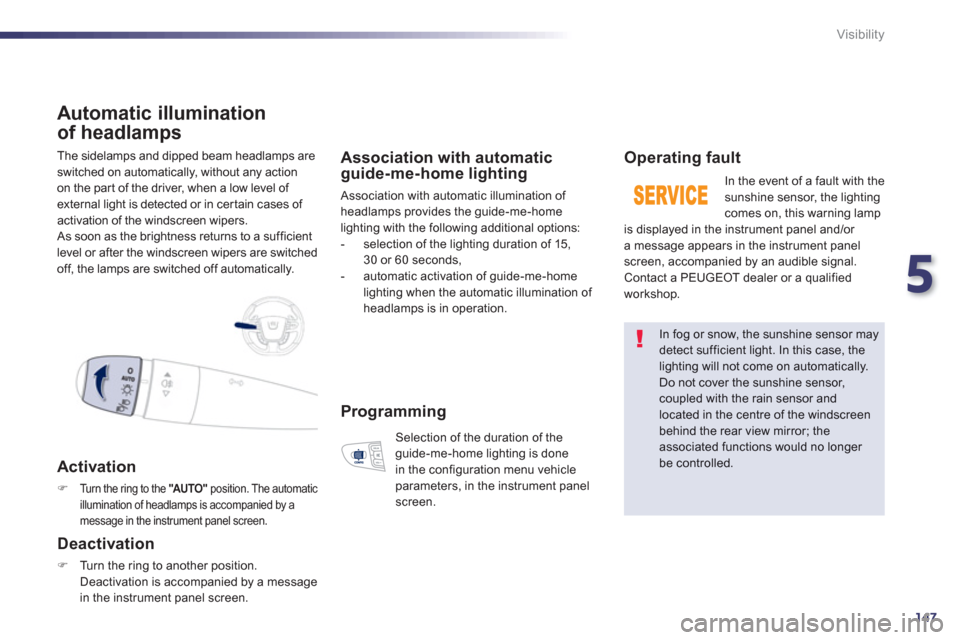
5
147
Visibility
The sidelamps and dipped beam headlamps are
switched on automatically, without any action
on the part of the driver, when a low level of external light is detected or in certain cases of
activation of the windscreen wipers.
As soon as the brightness returns to a sufficient
level or after the windscreen wipers are switched
o
ff, the lamps are switched off automatically.
Automatic illumination
of headlam
ps
Activation
�)Turn the ring to the "AUTO"position. The automatic
illumination of headlamps is accompanied by a message in the instrument panel screen.
Deactivation
�)Turn the ring to another position.
Deactivation is accompanied by a message
in the instrument panel screen.
Association with automaticguide-me-home lighting
Association with automatic illumination of headlamps provides the guide-me-home lighting with the following additional options:
- selection of the lighting duration of 15,
30 or 60 seconds,
- automatic activation o
f guide-me-home lighting when the automatic illumination of
headlamps is in operation.
Operating fault
In the event of a fault with the sunshine sensor, the lighting comes on, this warning lamp
is displayed in the instrument panel and/or
a message appears in the instrument panel screen, accompanied by an audible signal.
Contact a PEUGEOT dealer or a qualified
workshop.
In fog or snow, the sunshine sensor maydetect sufficient light. In this case, the lighting will not come on automatically. Do not cover the sunshine sensor,coupled with the rain sensor and located in the centre of the windscreenbehind the rear view mirror; theassociated functions would no longer be controlled.
Programming
Selection of the duration of theguide-me-home lighting is done
in the configuration menu vehicle
parameters, in the instrument panel screen.
Page 150 of 304
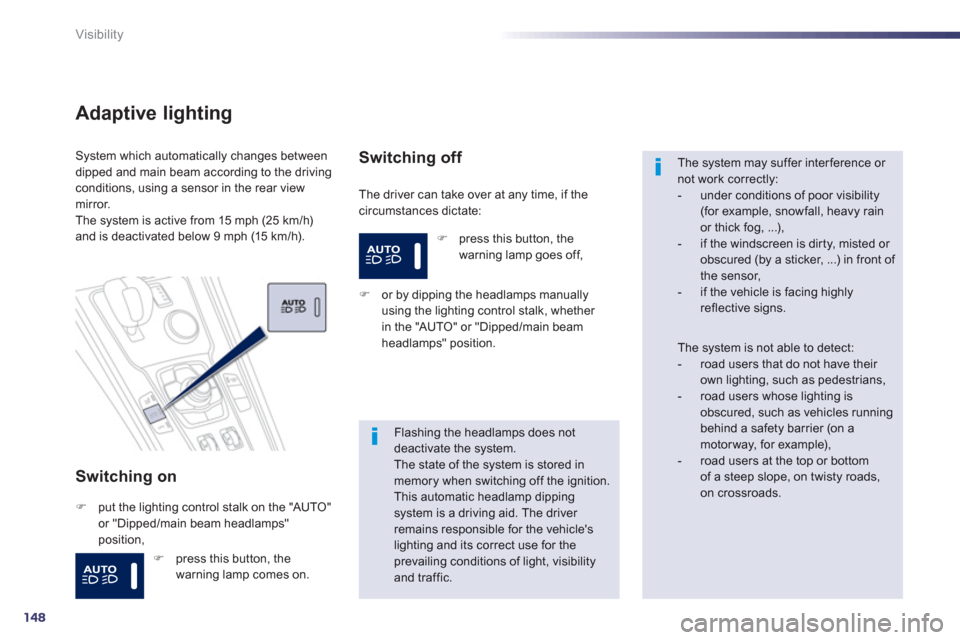
148
Visibility
Adaptive lighting
Switching on
The driver can take over at any time, if thecircumstances dictate:
System which automatically changes betweendipped and main beam according to the driving conditions, using a sensor in the rear view mirror.
The system is active from 15 mph (25 km/h) and is deactivated below 9 mph (15 km / h).
�)put the lighting control stalk on the "AUTO"
or "Dipped/main beam headlamps"
position,
Switching off
�)
or by dipping the headlamps manually using the lighting control stalk, whether
in the "AUTO" or "Dipped/main beam
headlamps" position.
Flashing the headlamps does notdeactivate the system.The state of the system is stored in memory when switching off the ignition. This automatic headlamp dipping system is a driving aid. The driver remains responsible for the vehicle'slighting and its correct use for theprevailing conditions of light, visibility and traffic.
The system may suffer interference or not work correctly:
- under conditions of poor visibility(for example, snowfall, heavy rain or thick fog, ...),
- if the windscreen is dir ty, misted or obscured (by a sticker, ...) in front of the sensor,
- if the vehicle is facing highly reflective signs.
The system is not able to detect:
- road users that do not have their own lighting, such as pedestrians,
- road users whose lighting isobscured, such as vehicles running behind a safety barrier (on amotorway, for example),
- road users at the top or bottomof a steep slope, on twisty roads, on crossroads.
�)press this button, the
warning lamp goes off,
�) press this button, the
warning lamp comes on.
Page 197 of 304
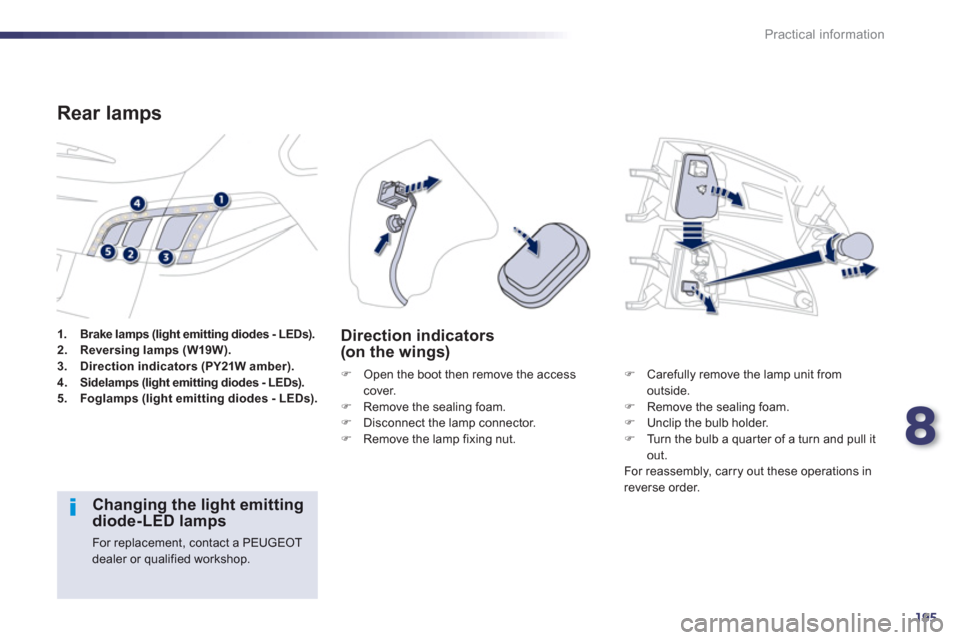
8
195
Practical information
1.Brake lamps (light emitting diodes - LEDs).2.Reversing lamps (W19W).3. Direction indicators (PY21W amber).4.Sidelamps (light emitting diodes - LEDs).5.Foglamps (light emitting diodes - LEDs).
Rear lamps
Direction indicators(on the wings)
�)
Open the boot then remove the accesscover.�)
Remove the sealing foam.�)
Disconnect the lamp connector. �)
Remove the lamp fixing nut.
�)
Carefully remove the lamp unit from outside.�)
Remove the sealing foam. �)
Unclip the bulb holder. �)
Turn the bulb a quar ter of a turn and pull itout.
For reassembly, carry out these operations in
reverse order.
Changing the light emitting diode-LED lamps
For replacement, contact a PEUGEOT dealer or qualified workshop.